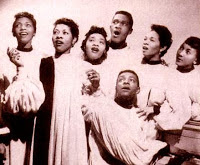
Emily "Cissy" Houston (née Drinkard; born
September 30, 1933) is an American soul and gospel singer. After a successful
career singing backup for such artists as Dionne Warwick, Elvis Presley and
Aretha Franklin, Houston embarked on a solo career, winning two Grammy Awards
for her work. Houston is the mother of singer
Whitney Houston, grandmother of
Whitney's daughter, Bobbi Kristina Brown, aunt of singers Dionne and Dee Dee
Warwick, and a cousin of opera singer Leontyne Price.
Houston, the youngest of eight children, was born Emily
Drinkard on September 30, 1933 in Newark, New Jersey to Nitcholas ‘Nitch’ and
Delia Mae (McCaskill) Drinkard. The Drinkard children attended revival-style
weekday services where they discovered gospel music. At the age of five, Houston
began singing with her sister Anne and two brothers Larry and Nicky. They
formed the gospel singing group, the Drinkard Four, performing regularly at the
New Hope Baptist Church. After graduating from Newark’s South Side High School,
she and her group, now The Drinkard Singers, continued performing and were
featured on a 1951 program at Carnegie Hall starring Mahalia Jackson.
Following her father’s death in 1955, Houston married her
first husband, Freddie Garland and the couple had one child, Gary. Two years
later, the two divorced and she met John Houston. Later that year, The Drinkard
Singers breakthrough performance at the Newport Folk Festival led to the album
A Joyful Noise on the RCA Victor label. The group included Houston’s nieces and
their adopted sister Judy Guions (Clay). In 1959, Cissy and John Houston were
married. Then, in 1963, while pregnant with her daughter Whitney Houston, she
formed the Sweet Inspirations with Doria Troy and Dee Dee Warwick
 |
| Cissy & Johm |
(Dionne’s
sister), and over the course of the next few years they provided backup vocals
to prominent artists including Aretha Franklin (Natural Woman) and Van Morrison
(Brown Eyed Girl). The group released their debut album in 1967 and toured the
country with Aretha Franklin and sang back up in Las Vegas with Elvis Presley.
Houston left the Sweet Inspirations in 1969 to pursue a
solo career. She recorded an impressive album for Commonwealth United in 1970,
Presenting Cissy Houston, which yielded a couple of small R&B/pop hits:
"I'll Be There" and "Be My Baby." Much in the manner of the
Sweet Inspirations, although the material consisted of fairly well-worn soul,
rock, and pop tunes, the state-of-the-art arrangements and gospel-ish vocals
made them sound fresh.
 |
| Add caption |
Her contract was sold to Janus Records later in the year,
and while she issued a few singles there until the middle of the '70s, she
never received the support and promotion she deserved. A case in point was her
little-known original version of "Midnight Train to Georgia," taken
to the top of the charts about a year later by Gladys Knight & the Pips.
In the early 1980s, Whitney joined her mother while Cissy
performed regular club dates in New York. In 1985, Whitney Houston’s first
album won a Grammy Award and catapulted her to pop super stardom. In 1987,
Whitney Houston’s second album, Whitney, was released, including the duet “I
Know Him So Well,” recorded by Whitney and Cissy. In 1988, the Whitney Houston
Foundation for Children was established, and Cissy was appointed president and
CEO.
 In 1992, Cissy was awarded the Medal for Distinguished
Humanitarian Leadership by the University of Medicine and Dentistry of New
Jersey. Two years later, she was honoured again, receiving two honorary
doctorates, and on March 2, 1995, she received the Rhythm and Blues Foundation
Pioneer Award. Houston won her first Grammy for “Face to Face” in 1996 and her
second in 1998 for the all-gospel release, He Leadeth Me.
In 1992, Cissy was awarded the Medal for Distinguished
Humanitarian Leadership by the University of Medicine and Dentistry of New
Jersey. Two years later, she was honoured again, receiving two honorary
doctorates, and on March 2, 1995, she received the Rhythm and Blues Foundation
Pioneer Award. Houston won her first Grammy for “Face to Face” in 1996 and her
second in 1998 for the all-gospel release, He Leadeth Me.
Houston remained active in both her community and the
music industry. In 2005, she released a compilation CD, The Cissy Houston
Collection, and in 2006, she recorded the song "Family First" with
Dionne Warwick and Whitney Houston for the soundtrack to the movie Daddy's Little
Girls. Additionally, she led the New Hope Baptist Church 200-plus member Youth
Inspirational Choir and in 2004 she was honoured by the church for 50 years of
service.
The tragic deaths of her daughter Whitney in 2012 and her
granddaughter Bobbi Kristina Brown in 2015 have certainly taken its toll on
Cissy and now she is now said to be battling another huge feat.In July 2018
According to Radar Online, Cissy Houston has been diagnosed with Dementia. A
source claims that the 84-year old repeats herself a lot as well as suffering
from a loss of memory: “She's in the early stages of dementia... She repeats
herself a lot and doesn't remember what she says. She just says she's getting
old.” Cissy also allegedly disowned her son after he revealed details regarding
the reported assault she endured as a child within The Whitney Houston documentary
which is currently in theaters.
(Compiled and edited from various sources mainly visionaryproject.org
& All Music)




















































